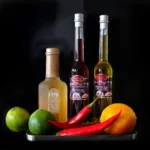Vegetable Pickle using Vinegar
Here's a detailed method for preserving vegetables using vinegar:
Yield: 1 jar
Equipment
- Glass jars with tight-fitting lids
- Boiling water bath canner (for long-term preservation)
- Large Pot
- Mixing Bowls
- Cutting board and knife
Materials
- Fresh vegetables e.g., cucumbers, carrots, cauliflower, bell peppers
- Vinegar white vinegar or apple cider vinegar
- Water
- Salt
- Optional: spices e.g., dill, garlic, peppercorns, mustard seeds
Instructions
Preparation:
- Wash and sanitize the glass jars and lids by running them through the dishwasher or boiling them in water.
- Wash the vegetables thoroughly and trim them to the desired size and shape. Remove any bruised or damaged portions.
Brine Preparation:
- In a pot, combine vinegar, water, and salt in the following ratio: 1 part vinegar, 1 part water, and 1 tablespoon of salt per cup of liquid.
- You can also add spices like dill, garlic, mustard seeds, and peppercorns to the brine for flavor.
Blanch Vegetables (Optional):
- Some vegetables benefit from blanching before pickling. Blanching involves briefly boiling the vegetables to slightly soften them and preserve their color.
- After blanching, immediately plunge the vegetables into ice water to stop the cooking process.
Pack the Jars:
- Pack the prepared vegetables into the sanitized glass jars, leaving about 1 inch of space at the top.
- Pour the prepared brine over the vegetables, ensuring they are fully covered. Leave about ½ inch of headspace between the brine and the jar's rim.
Remove Air Bubbles:
- Gently tap the jars on a countertop to remove any trapped air bubbles. This helps ensure that the brine fully penetrates the vegetables.
Seal the Jars:
- Wipe the jar rims clean to ensure a proper seal. Place the lids on the jars and screw on the bands until they are fingertip-tight.
Processing (Optional for Long-Term Preservation):
- If you plan to store the pickled vegetables for an extended period, you can process the jars in a boiling water bath canner.
- Place the sealed jars in the canner, making sure they are fully submerged in water. Process them according to recommended times for your altitude and jar size. This helps create a vacuum seal and extend shelf life.
Cooling and Storage:
- After processing or simply packing the jars, allow them to cool at room temperature.
- Store the cooled jars in a cool, dark place, such as a pantry or cellar. Properly sealed and processed jars can last for several months to a year.
Notes
Remember to follow safe canning practices, especially if you're planning to store pickled vegetables for an extended period. If you're new to canning, it's a good idea to consult reliable sources or guides on safe home canning practices to ensure the preservation process is done correctly and safely.
